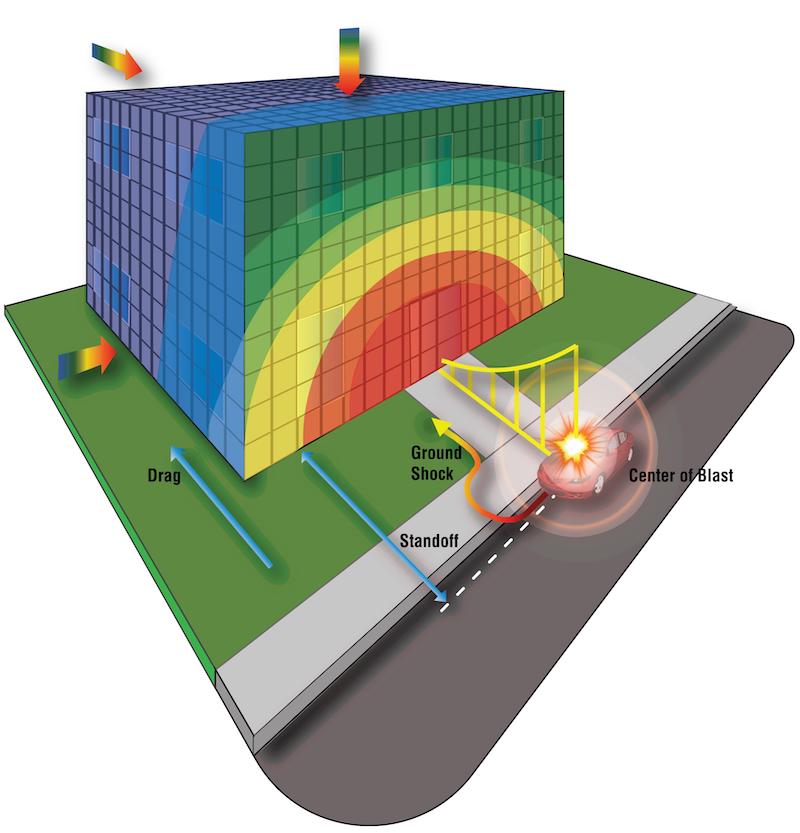IEI routinely conducts peer reviews of both structural and physical security designs on behalf of the federal government. This is where we noticed the gap between theory and incorporation of physical security into the design documents. This appears to be the result of a couple of myths in the field of physical security, often referred to as blast consulting.

Myth #1: Physical security consultants can begin their involvement with the project after 35% design of the project is complete. This is far too late in the design process. By this time, sites have been selected and laid out, and the building structural and envelope systems have been selected. Involvement at this late stage can lead to costly design changes and increased construction cost.
Myth #2: Physical security consultants do not need to assume Engineer of Record (EOR) responsibilities. While in theory this is true, it is very difficult to execute, especially by those who lack experience as an engineer of record. The result is often a nice report of requirements by the physical security consultant at the end of the project which have not been incorporated into the construction documents. While we have successfully completed projects as purely the physical security consultant to the design team, it was only due to understanding of the design process and diligent communication with the design team and review of interim submittal documents.
When considering risk assessment for a facility, mitigation options should be identified to reduce risk, threat, and/or vulnerability. Acceptable amount of risk should be determined, and identify levels of protection to be given. Not all risk can be eliminated, and a balance must be struck.
It is highly advantageous for the physical security consultant to assume Engineer of Record responsibilities. If this does not happen, you will often be left with a report of requirements by the consultant that have not been actually incorporated into the construction documents.
Unified Facilities Criteria
Unified Facilities Criteria (UFC) 04-010-01 identifies 21 standards that must be considered for physical security design. These standards include but are not limited to: standoff distances, unobstructed space, access roads, parking conditions, progressive collapse, and structural isolation.
The UFC defines Progressive Collapse as “The spread of an initial local failure from building element to building element, eventually resulting in the collapse of an entire structure or a disproportionately large part of it.” Progressive Collapse can be prevented by adding redundancy and local hardening to the structural design of the building.
UFC 4-010-01 aim to reduce collateral damages and the scope and severity of mass casualties in buildings in the event of a terrorist attack. It encourages the use of cost effective, implementable, and enforceable means of protecting personnel if such an attack were to happen.
What is Progressive Collapse and How Can it be Prevented?
The prevention of progressive collapse—an event where all or part of a structure collapses after being damaged by an explosion, accident or deliberate act—is a building design element that redistributes the load of a failed column to adjacent columns. Blast protection includes blast resistant walls, doors and windows, among other elements.
Progressive Collapse can be seen as the failure of a localized member that leads to the failure of adjacent members, eventually causing a massive amount of damage proportionate to the original failed member.
To prevent catastrophic progressive collapse in buildings and parking structures, extensive evaluations of existing structures should take place. These include:
- Reviewing documentation – Look at design and shop drawings, electrical and mechanical plans, calculations, any recent reports, et. The structural engineer should identify any questionable design aspects, including any recent updates that might affect the weight of the structure.
- Materials studies – If materials vary at any point during construction (if they differ from those originally specified in the design), this creates the potential for diminished performance. Over time, there can be some deterioration due to environmental exposure.
- Assess the existing capacity of structural systems – To determine the strength and ductility of the entire system, structural analyses of the estimated material properties and connection detailing must be carried out.
Contact Innovative Engineering, Inc. for Progressive Collapse and Physical Security Analysis
IEI takes a holistic approach that includes all disciplines. We know what it takes to ensure the physical security requirements get incorporated into the construction documents regardless of discipline.
Our unique expertise and experience help A/E & Design-Build teams win projects and economically incorporate physical security into new and renovated buildings and other structures. Our expertise not only matches that of world-renowned experts in the physical security field, our extensive engineer of record experience brings a unique blend to the project team. We have been there and done that. We not only have in-depth knowledge of physical security criteria; we have access to interpretations and those who make them. The result is economic design with no surprises.
